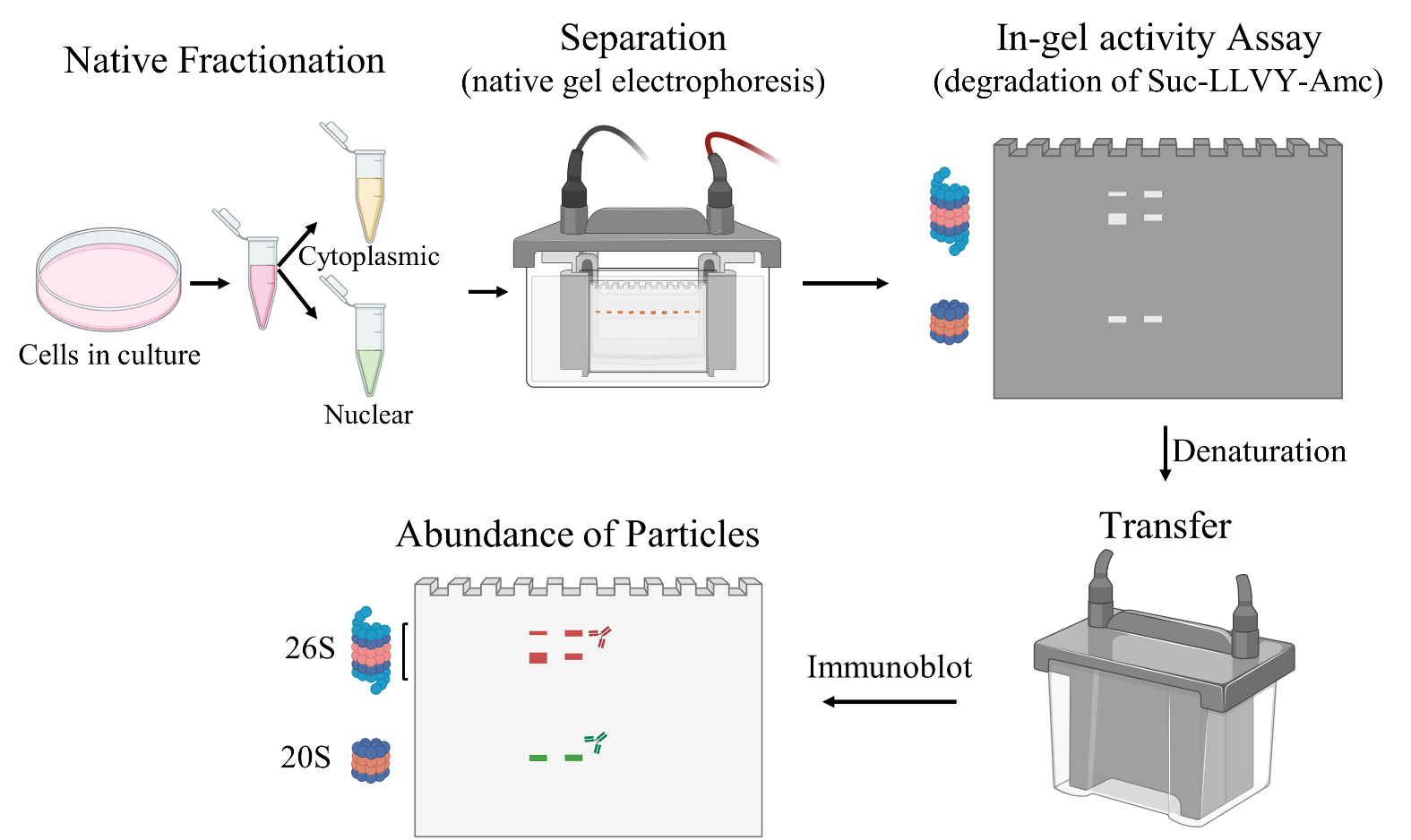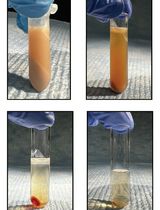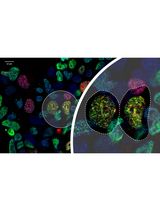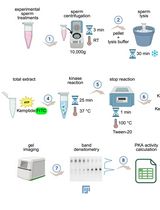- EN - English
- CN - 中文
Fractionation of Native Protein Complexes from Mammalian Cells to Determine the Differential Proteasome Activity and Abundance
分离哺乳动物细胞中的天然蛋白复合物以测定差异蛋白酶体活性和丰度
发布: 2023年09月20日第13卷第18期 DOI: 10.21769/BioProtoc.4822 浏览次数: 2121
评审: Neha NandwaniPetru-Iulian TrasneaAnonymous reviewer(s)
Abstract
Eukaryotic cells have different types of proteasomes that differ in size. The smallest proteolytically active particle is the 20S proteasome, which degrades damaged and oxidized proteins; the most common larger particle is the 26S proteasome, which degrades ubiquitylated proteins. The 26S proteasome is formed by a 20S particle capped with one or two regulatory particles, named 19S. While proteasome particles function in the cytoplasm, endoplasmic reticulum, and nucleus, our understanding of their abundance and activity in different cellular compartments is still limited. We provide a three-step protocol that first involves detergent-based fractionation of the cytoplasmic and nuclear compartments, maintaining the integrity and activity of proteasome complexes. Second, the protocol employs native gel separation of large multiprotein complexes in the fractions and a fluorescence-based in-gel quantitation of the activity and different proteasome particles. Finally, the protocol involves protein in-gel denaturation and transfer to a PVDF membrane. Western blotting then detects and quantifies the different proteasome particles. Therefore, the protocol allows for sensitive measurements of activity and abundance of individual proteasome particles from different cellular compartments. It has been optimized for motor neurons induced from mouse embryonic stem cells but can be applied to a variety of mammalian cell lines.
Key features
• Protocol for fractionation of active nuclear and cytoplasmic proteasome complexes.
• Native electrophoresis and fluorescence-based in-gel activity assay, which allows the visualization and quantification of active complexes within the acrylamide gel matrix.
• In-gel protein denaturation followed by transfer of complexes to PVDF membrane, which allows the analysis of complexes’ abundance using antibodies.
Graphical overview

Background
The proteasome is an essential component of ATP-dependent proteolysis in eukaryotic cells and is responsible for the degradation of most cellular proteins (Goldberg, 2003; Rousseau and Bertolotti, 2018). It is therefore essential for the maintenance of proteostasis. Since the loss of proteostasis is a hallmark of several diseases, the proteasome has become an attractive drug target (Schmidt and Finley, 2014). Several proteasome inhibitors have either been approved for clinical use or are currently in clinical trials (Buac et al., 2013).
There are two major proteasome subunits within the cell, in addition to other less common subunits (Dahlmann, 2016). The smaller subunit comprises the 20S proteasome (700 kDa), which degrades damaged and oxidized proteins, without the need for ubiquitylation. In comparison, the larger subunit, named 26S (2,000–3,000 kDa) proteasome, selectively degrades ubiquitylated proteins. The 26S proteasome is formed by one 20S proteasome capped with one or two regulatory subunits named 19S (Tomko and Hochstrasser, 2013). The barrel-shaped 20S proteasome consists of four stacked heteroheptameric rings: two α-rings on the ends that sandwich a pair of β-rings in between. The six proteolytically active sites are located within the β-rings (Tomko and Hochstrasser, 2013). Entry of ubiquitylated proteins into the 20S is controlled by the 19S subunit, which has specific ubiquitin receptors (Martinez-Fonts et al., 2020). The abundance and activity of the different proteasome subunits are extensively controlled, involving a network of chaperones and regulators (Marshall and Vierstra, 2019; Schnell et al., 2022).
Proteasome-based degradation has first been detected in the cytoplasm and the endoplasmic reticulum (von Mikecz, 2006; Maghames et al., 2018). However, later work also identified highly active degradation of ubiquitylated proteins in the nucleus by the nuclear proteasome (von Mikecz, 2006). Most recent evidence points to AKIRIN2 as a highly conserved protein that controls the nuclear import of proteasomes (de Almeida et al., 2021). These developments highlight the importance of understanding the differential abundance and activity of proteasome subunits in the cytoplasm and nucleus of eukaryotic cells.
This protocol represents a significant advancement in cellular fractionation techniques, as it enables the separation of cellular components while preserving the integrity of protein complexes. We adapted two previously published protocols that allow fractionation of native proteins using detergents (DeCaprio and Kohl, 2020) and a native separation of complexes under nondenaturing conditions with an in-gel proteasome activity assay (Yazgili et al., 2021). Firstly, the plasma membrane is selectively permeabilized using digitonin, which effectively solubilizes it without disrupting intracellular membranes that contain lower levels of cholesterol. Digitonin binds to the membrane, forming pores by complexing with membrane cholesterol and other sterols (Tang et al., 2021). Next, the cytoplasmic lysate is isolated, and the remaining pellet is washed. This step removes contaminating lipidic membranous organelles, resulting in a highly enriched nuclear fraction (Ridsdale et al., 2006; Malhotra, 2008). The different proteasome subunits are then separated using gel separation techniques under native conditions that preserve their functional activity. Both the loading and running buffers used in this step contain ATP, providing an available energy source. Moreover, the buffers contain DTT, which protects against non-proteasomal protease activities. To assess proteasome activity, the protocol utilizes fluorogenic peptides known as Suc-LLVY-AMC, which act as substrates for the 20S and 26S proteasome subunits (Goldberg, 2003). When the peptides are cleaved by the proteasome, the fluorophore called AMC is released, generating a fluorescent signal that can be measured, including as an in-gel activity assay (Yazgili et al., 2021).
After performing gel electrophoresis, the gel content is denatured, and the content is transferred onto a PVDF membrane to facilitate further analysis using specific antibodies. The abundance of the 20S core subunit of the proteasome can be determined by detecting Psma1-7, while the presence of the 19S regulatory subunit is indicated by Psmc3. The colocalization of Psmc3 and Psma1-7 antibodies provides confirmation of the assembly of the fully functional 26S proteasome subunit. The intensity of the bands observed on the PVDF membrane reflects the relative abundance of the proteins, serving as a reliable indicator of the respective subunit quantities.
Overall, this protocol offers a robust method for isolating and quantifying active proteasome subunits, enabling a comprehensive analysis of their functional state.
Materials and reagents
Materials
Cell cultures in plates or suspension (here: neurons differentiated from mouse embryonic stem cells)
0.45 μm sterile filter (Corning, catalog number: 430514)
Cell lifter (Sigma, catalog number: SILA0008)
1.5 mL tubes (Eppendorf, catalog number: 022363204)
Pipette tips (USA Scientific, catalog number: various)
Glass slides (Corning, catalog number: 12-553-10)
Coverslips (Menzel Gläser, catalog number: 630-2118)
NU-PAGE 3%–8% tris-acetate (Thermo Fisher, catalog number: EA0378)
PVDF membrane (Millipore, catalog number: IPFL00010)
Micropipettes (Gilson, catalog number: various)
Microcentrifuge (Eppendorf, catalog number: 5427R)
Sonicator (Covaris, catalog number: S220)
Mini gel tank (Thermo Fisher, catalog number: A25977)
Power supply (Bio-Rad, catalog number: 1645050)
Mini Trans-Blot Cell (Bio-Rad, catalog number: 1703930)
Fluorescence imaging system Gel Doc (Bio-Rad) with the filter for ethidium bromide
NIR imaging system (Odyssey Clx, LiCOR Biosciences)
Cold room at 4 °C
Shaker (Boekel Scientific, catalog number: 260350)
Reagents
ddH2O
Phosphate buffered saline (PBS) (Thermo Fisher Scientific, catalog number: 14190250)
PIPES (Sigma-Aldrich, catalog number: P6757)
NaCl (Fisher Scientific, catalog number: BP350)
MgCl2 hydrate (Sigma-Aldrich, catalog number: M2670)
EDTA (EMD Millipore, catalog number: 324503)
Digitonin (EMD Millipore, catalog number: 300410)
Protease inhibitors (Roche, catalog number: 11697498001)
NaOH (Sigma-Aldrich, catalog number: L4509)
Trypan blue (Invitrogen, catalog number: 15250061)
Igepal (Sigma-Aldrich, catalog number: I8896)
DC Protein quantification kit (Bio-Rad, catalog number: 5000111)
Orange G (Sigma-Aldrich, catalog number: 861286)
Glycerol (Sigma-Aldrich, catalog number: G2025)
Tris (Sigma-Aldrich, catalog number: T6066)
DTT (Cayman Chemical Company, catalog number: 700416)
ATP (Sigma-Aldrich, catalog number: A2383)
Boric acid (Sigma-Aldrich, catalog number: B6768)
MgCl2 (Sigma-Aldrich, catalog number: M2670)
Tris-HCl pH 7.5 (Thermo Fisher Scientific, catalog number: 15567027)
Suc-LLVY-AMC (Bachem, catalog number: 4011369.0100)
Sodium dodecyl sulfate (SDS) (Fisher Scientific, catalog number: BP166-500)
Na2CO3 (Sigma-Aldrich, catalog number: S7795)
2-mercaptoethanol (Sigma-Aldrich, catalog number: M6250)
Glycine (Sigma-Aldrich, catalog number: G8898)
Methanol (Sigma-Aldrich, catalog number: 179337)
Tris Buffered Saline (TBS 20×) (VWR, catalog number: J640)
Tween 20 (Sigma-Aldrich, catalog number: P7949)
Blocking buffer in TTBS (LiCOR Biosciences, catalog number: 927-60001)
Core proteasome units (20S), Psma1-7 antibody (1:1,000) (Enzo Life Sciences, catalog number: BML-PW8195-0100)
Regulatory proteasome units (26S), Psmc3 antibody (1:1,000) (Cell Signaling Technology, catalog number: 25430S)
Mouse secondary antibody (1:10,000) (LiCOR Biosciences, catalog number: 925-32210)
Rabbit secondary antibody (1:10,000) (LiCOR Biosciences, catalog number: 926-68073)
Solutions
4× PIPES buffer (see Recipes)
Cytoplasmic extraction buffer (pH 6.8) (see Recipes)
Nuclear extraction buffer (pH 6.8) (see Recipes)
4× Loading buffer (pH 7.3) (see Recipes)
8× TBE buffer pH 8.3 (see Recipes)
Native gel running buffer (pH 8.3) (see Recipes)
250× ATP/MgCl2 (see Recipes)
Reaction buffer for in-gel proteasome activity assay (see Recipes)
Denaturation buffer (see Recipes)
Tris-glycine transfer buffer (see Recipes)
T-TBS (see Recipes)
Recipes
4× PIPES buffer
Reagent Final concentration Quantity NaCl 400 mM 5.8 g PIPES 40 mM 3 g 1 M NaOH 1 M enough to dissolve PIPES MgCl2 hydrate 12.5 mM 0.64 g Final volume 250 mL Dissolve NaCl in 150 mL of ddH2O. Dissolve PIPES in a small volume of NaOH (start with 2 mL and carefully increase, only if necessary). Mix the PIPES solution with NaCl solution. Add MgCl2 hydrate to the mixture. Adjust the final volume to 250 mL. Filter through a 0.45 μm sterile filter. Store at 4 °C or aliquot and freeze (for longer storage).
Cytoplasmic extraction buffer (pH 6.8)
Reagent Final concentration Quantity 4× PIPES buffer 1× 25 mL Digitonin 0.015% 18.75 mg EDTA 3 mM 0.6 mL Protease inhibitors 1 tablet for 10 mL of buffer Final volume 100 mL Dissolve digitonin in 10 mL of 4× PIPES buffer. Add the remaining 4× PIPES buffer, EDTA, and 20 mL of ddH2O. Allow the mixture to cool at 4 °C. Adjust the pH to 6.8 and add ddH2O for a total volume of 100 mL. The cytoplasmic extraction buffer can be kept at 4 °C for up to one month. The protease inhibitors should be added fresh to the mixture.
Nuclear extraction buffer (pH 6.8)
Reagent Final concentration Quantity 4× PIPES buffer 1× 25 mL Igepal 0.1% 100 μL EDTA 3 mM 0.6 mL Protease inhibitors 1 tablet for 10 mL of buffer Final volume 100 mL Add 4× PIPES buffer, Igepal, EDTA, and 20 mL of ddH2O. Allow the mixture to cool at 4 °C. Adjust the pH to 6.8 and add ddH2O for a total volume of 100 mL. The nuclear extraction buffer can be kept at 4 °C for up to one month. The protease inhibitors should be added fresh to the mixture.
4× Loading buffer (pH7.3)
Reagent Final concentration Quantity Orange G 0.01% 1 g Glycerol (87%) 43.50% 5 mL Tris (pH 7.5, 500 mM) 250 mM 5 mL Final Volume 10 mL Dissolve all the chemicals for a final volume of 10 mL in ddH2O; the buffer should be kept at 4 °C.
8× TBE buffer pH 8.3
Reagent Final concentration Quantity Tris base 712 mM 86.4 g Boric acid 712 mM 44 g EDTA Na2 16 mM 5.6 g Final volume 1 L Native gel running buffer (pH 8.3)
Reagent Final concentration Quantity 8x TBE buffer 1× 100 mL ATP 413 μM 200 mg MgCl2 (1 M) 2 mM 1.6 mL DTT (1 M) 0.5 mM 400 μL Final volume 800 mL Dissolve all chemicals in 600 mL of ddH2O, adjust the pH to 8.3, and complete with ddH2O to a final volume of 800 mL. This solution can be prepared in advance and kept at 4 °C; however, ATP, MgCl2, and DTT need to be added freshly to the mixture.
250× ATP/MgCl2
Reagent Final concentration Quantity MgCl2 hydrate 2.5 M 1.0165 g ATP 250 mM 0.3026 g Final volume 2 mL Dissolve all the chemicals for a final volume of 2 mL in ddH2O; the buffer should be kept at -80 °C or prepared fresh.
Reaction buffer for in-gel proteasome activity assay
Reagent Final concentration Quantity Tris (pH 7.5, 100 mM) 1× 12.5 mL 250× ATP/MgCl2 1× 100 μL DTT (1 M) 1 mM 25 μL Suc-LLVY-AMC (2 mM, dissolved in DMSO) 48 μM 600 μL Final Volume 25 mL Dissolve all chemicals in 25 mL of ddH2O. The reaction buffer can be prepared in advance and kept at 4 °C. However, ATP and DTT should be added freshly to the mixture, while the proteasome substrate Suc-LLVY-AMC should be added immediately before incubation of the gels in reaction buffer.
Denaturation buffer
Reagent Final concentration Quantity SDS 2% 10 g Na2CO3 66 mM 3.5 g β-mercaptoethanol 1.50% 7.5 mL Final volume 500 mL In a fume hood, dissolve all chemicals in 500 mL of ddH2O.
Tris-glycine transfer buffer
Reagent Final concentration Quantity Tris 48 mM Glycine 39 mM SDS 1.3 mM Methanol 20% 200 mL Final volume 1 L Dissolve Tris and glycine in 600 mL of ddH2O and adjust to pH 8.3. Add SDS and methanol. Adjust the volume to 1 L with ddH2O. The transfer buffer should be kept at 4 °C until use.
T-TBS
Reagent Final concentration Quantity 20× TBS 1× 100 mL Tween 20 0.10% 2 mL Final volume 2 L Dilute 10× TBS in 1.7 L of ddH2O, add the Tween 20, and adjust with ddH2O to a final volume of 2 L.
Time considerations
Native protein fractionation: 2–3 h.
Native gel electrophoresis: 4 h.
Activity assay: 45 min.
Transfer to membrane and immunoblot: 2 days.
Software
Image StudioTM Acquisition Software (LiCOR Biosciences)
Fiji ImageJ (https://imagej.net/software/fiji/)
Procedure
文章信息
版权信息
© 2023 The Author(s); This is an open access article under the CC BY-NC license (https://creativecommons.org/licenses/by-nc/4.0/).
如何引用
Fiore, A. P. Z. P. and Vogel, C. (2023). Fractionation of Native Protein Complexes from Mammalian Cells to Determine the Differential Proteasome Activity and Abundance. Bio-protocol 13(18): e4822. DOI: 10.21769/BioProtoc.4822.
分类
生物化学 > 蛋白质 > 降解
分子生物学 > 蛋白质 > 活性
您对这篇实验方法有问题吗?
在此处发布您的问题,我们将邀请本文作者来回答。同时,我们会将您的问题发布到Bio-protocol Exchange,以便寻求社区成员的帮助。
Share
Bluesky
X
Copy link













